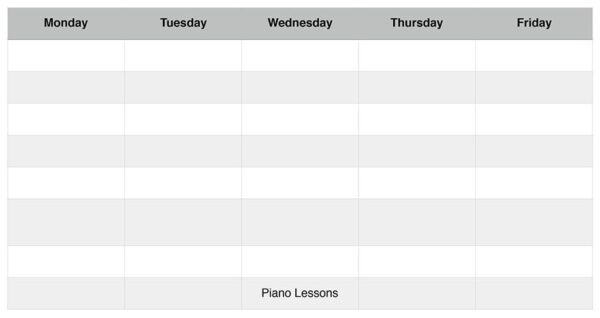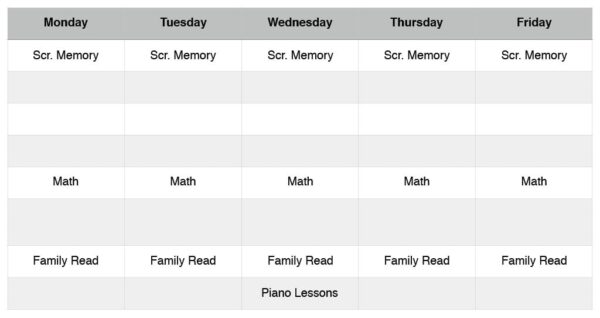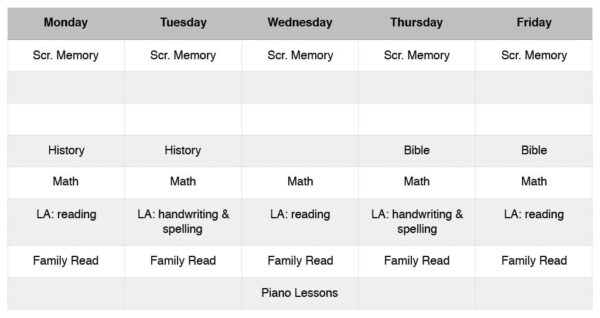Free shipping on USA orders over $129!
Many of you are in the midst of planning for your home schools, so I thought it might be helpful to share a quick explanation of how I plan my weekly schedule.
I’ve been using this 1-2-3 method of planning a weekly schedule for about 15 years now, so you know two things: first, it’s simple; and second, it works. Here’s how.
Lay out your school days in columns, one day at the top of each column. You can do this on a spreadsheet on your computer, on a whiteboard with dry erase markers, on the table or floor with index cards, on the wall with self-stick notes, on grid paper with colored pencils, on a desk calendar with crayons, . . . the possibilities are endless. Use what makes you happy.
Step 1: Reserve Slots for Outside Activities
First, block out the time slots you need for outside activities. Think about any recurring errands, appointments, lessons, or meetings that you participate in. Write each one down under the day of the week on which it occurs. If it happens first thing in the morning, put it at the top of that day’s column. If it occurs in the afternoon, put it farther down in its day’s column.
So your columns might look something like this.


Step 2: Pop In Everyday Subjects
Second, write in the subjects that you do every day. For me those are
- Scripture Memory
- Literature/Family Read-Aloud
- Math
And the columns look like this.


Step 3: Spread Out Variety Subjects
Third, spread the rest of the subjects throughout the week to add variety, so each day is not exactly like the rest. Keep an eye on the big picture, being careful not to overload any day. (That’s why we put the outside activities in place first.) Here are the subjects that I sprinkle throughout the week.
- History (anywhere from 1 to 4 days per week, depending on the time period)
- Bible (anywhere from 1 to 4 days per week, depending on the time period)
- Language Arts (you can do this 5 days per week, but try to focus on different skills on different days, not everything every day)
At this point the columns might look like this.


Add the onesies and twosies . . .
- Science (2 days per week for younger students, more for older)
- Geography (1 day per week, but also occurs in other subjects)
- Hymn Study (2 days per week)
- Foreign Language (2 days per week)
- Picture Study (1 day per week)
- Music Study (1 day per week, but you can play the music in the background on several days)
- Nature Study (1 day per week)
- Poetry (1 day per week)
- Handicrafts or Art Instruction (1 day per week)
- Shakespeare (1 day per week)
And you’ve got your weekly schedule.


I highly recommend that you take a final pass through to look at each day’s column by itself. Make sure you don’t have two heavy read-and-narrate subjects back to back. You want them spread out throughout the day with other lighter subjects between.
I like to use one weekly schedule for a term and then rearrange to keep things fresh.
There you have it: a weekly schedule in 3 simple steps. Any questions?
Resources to Help with Planning
For more help with creating a custom schedule for your family, take a look at Planning Your Charlotte Mason Education.
If you prefer to have the planning already done for you, our daily lesson plan books could be what you need. Each gives you a complete year’s book list, weekly schedule, and daily itineraries so you know what to do for each day’s lesson. We have three series of lesson plan books, you can pick and choose or put them together to make a complete CM curriculum.
- History Studies—plans for history, geography, Bible; for the whole family
- Enrichment Studies—plans for Scripture memory, hymn study, foreign language, poetry, music study, Shakespeare, nature study, handicrafts or art instruction, family read-aloud, plus habit training; for the whole family
- Individual Studies—plans for language arts, math, and science; by grade level (Grades 1–8 currently available)
Podcast: Play in new window | Download


Thank you for the articel. Sounds very good. Yet in reality it isn’t always so easy, especially with many children and with older students. We have two or even three foreign languages in Switzerland. This is a lot of work. So we have definitely more every day subjects and more individual subjects :-(.
Since our oldest student is in 7th grade I need more than 60 minutes individual time for her only. (Until last year, 45 minutes per day per student were enough.) This is not easy because I have three younger students as well. The days sometimes seem to be too short :-(.
Anyway, the article is helpful. Thank you.
Yes, the schedule above is a sample for just one child. Creating a schedule for multiple children can certainly be a challenge. That’s one reason I try to combine all the students for as many subjects as possible. Here is a sample of dividing the work into Family and Individual subjects. If you can get all the Family work done in a couple of hours, that leaves just the Individual work by grade level to finish out the day.
Charlotte’s students did multiple foreign languages, so you’re in good company. I was just looking at one of her schedules to try to get some ideas for you. Here is the foreign-language work that her grades 7–9 students did each week:
Monday: French (45 minutes)
Tuesday: German (30 minutes), German song (20 minutes), Latin (45 minutes)
Wednesday: Latin (20 minutes), Italian (45 minutes)
Thursday: French song (20 minutes), French (45 minutes)
Friday: German (45 minutes)
Saturday: Latin (30 minutes), Italian (45 minutes)
So it looks like that age of students were doing close to an hour of foreign language work each day in her schedule too. Keep in mind that these lessons were not done back-to-back; other subjects were inserted between in order to use a different part of the brain and prevent fatigue. Anyway, I thought it was interesting to see how she scheduled foreign language too.
Thanks a lot Sonya,
I’m glad I can ask.
If you believe it or not, right now it’s my biggest challenge to find out how I can combine a CM education as you (and other ressources) teach it and everything a Swiss curriculum demands. And all of this for 7th-9th grade on a good level!
Our children are now in 1st, 3rd, 5th and 7th grade.
A CM education is definately what I want. That’s why I don’t plan to give my children to public school once our mission time in RO is coming to an end and we are returning to Switzerland definately.
My problems right now are the following:
– I need 45-60 minutes individual work for every child. My 3rd grader doesn’t have enough independent work to do for these hours, but he is cognitively quite gifted. That’s why he often disturbes the others. If I give him more individual work to do, he struggles with that and I do have more to correct which is hard for me.
– Besides a literature book that I read to all of the children and which they narrate, the older students (5th and 7th grade) do read their individual literature books in her mother tongue (German). These individual books they narrate on my smartphone. Besides literature they read in English and narrate. So I do have every evening 4x 8-15 minutes to listen to all of these narrations and to give a feedback. I see now that this is too much for me. Any ideas? (They like narrating orally very much).
– My 7th grader isn’t included anymore in all of the family work. She says she has soooo much individual work to do (which is quite true) that it’s hard to get her for the family work. It’s a pity. Would you insist or would you leave the family work voluntary for her? Or would you give her the composer study/poetry/and picture study for individual work?
She still does with us Scripture study, Bible, Hymn study and Drawing.
RE your 3rd grader: perhaps we could brainstorm some ideas of things to do as independent work that won’t cause more correction work for you. Maybe listen to audiobooks (and follow along in the printed book if desired); work on an art project (possibly using video guidance); take nature photos and create/add to a nature blog (private blog) or scrapbook; learn typing with software that does the correcting and evaluating automatically (if he is reading fluently); do P.E. on a mini trampoline or stationary bike; gardening.
RE your 5th and 7th grader: You might use some of the other narration ideas sometimes; for example, “come up with five questions covering what you read” or “tell what you think will happen next and why.” Another option might be to alternate between written and oral; so maybe 5th grader is required to give you oral narrations for his/her Book A, and 7th grader is required to give you written ones for his/her Book A. When they move on to Book B, you switch and have 5th grader do written and 7th grader do oral. You could also alternate written and oral per chapter, but that can become disjointed and hinder the overall flow of a book.
RE your 7th grader’s work load: If she likes having all of that individual work, I don’t see any harm in feeding that desire. Could you possibly move poetry and picture study and composer study to a shared meal time when she will be with the family anyway and not feel like you are taking away time she needs for other things? Maybe if you look at a picture or read a poem or listen to music during or immediately after lunch while still at the table, you will still be able to enjoy that subject as a whole family but not interrupt her independent-work schedule.
I hope some of these ideas help!
Thanks a lot. Yes, it’s helpful.
I’ll try those ideas.
P.S:
We have for my 7th grader
5x 45 minutes of French,
5 x 30 minutes of English and
4x 30 minutes of Italian per week.
Plus Romanian (this is more free. She just reads Romanian books.)
It’s a lot. Do you see? She desperately wants that much. Italian would’t be necessary so much and I tried to reduce, but she likes it.
Thank you for the ideas. You have math and LA listed together; should they be separated to avoid fatigue like Charlotte mentions?
You should be fine doing those two subjects back to back. Working with numbers uses a different part of the brain than working with words or practicing fine motor skills with handwriting. This blog post on Sequencing Your Day might help too.